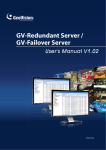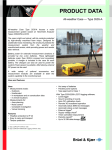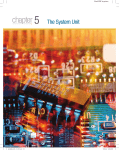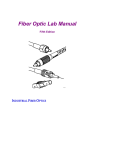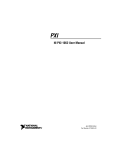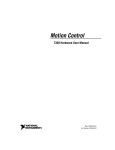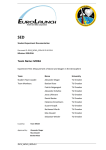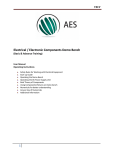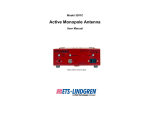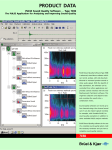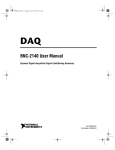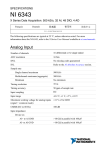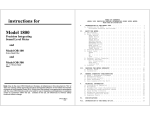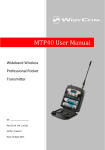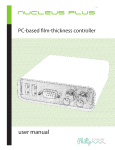Download BNC-2140 User Manual
Transcript
DAQ BNC-2140 User Manual Dynamic Signal Acquisition Signal Conditioning Accessory BNC-2140 User Manual June 2003 Edition Part Number 321933D-01 Support Worldwide Technical Support and Product Information ni.com National Instruments Corporate Headquarters 11500 North Mopac Expressway Austin, Texas 78759-3504 USA Tel: 512 683 0100 Worldwide Offices Australia 1800 300 800, Austria 43 0 662 45 79 90 0, Belgium 32 0 2 757 00 20, Brazil 55 11 3262 3599, Canada (Calgary) 403 274 9391, Canada (Montreal) 514 288 5722, Canada (Ottawa) 613 233 5949, Canada (Québec) 514 694 8521, Canada (Toronto) 905 785 0085, Canada (Vancouver) 514 685 7530, China 86 21 6555 7838, Czech Republic 420 2 2423 5774, Denmark 45 45 76 26 00, Finland 385 0 9 725 725 11, France 33 0 1 48 14 24 24, Germany 49 0 89 741 31 30, Greece 30 2 10 42 96 427, India 91 80 51190000, Israel 972 0 3 6393737, Italy 39 02 413091, Japan 81 3 5472 2970, Korea 82 02 3451 3400, Malaysia 603 9131 0918, Mexico 001 800 010 0793, Netherlands 31 0 348 433 466, New Zealand 1800 300 800, Norway 47 0 66 90 76 60, Poland 48 0 22 3390 150, Portugal 351 210 311 210, Russia 7 095 238 7139, Singapore 65 6226 5886, Slovenia 386 3 425 4200, South Africa 27 0 11 805 8197, Spain 34 91 640 0085, Sweden 46 0 8 587 895 00, Switzerland 41 56 200 51 51, Taiwan 886 2 2528 7227, Thailand 662 992 7519, United Kingdom 44 0 1635 523545 For further support information, refer to the Technical Support and Professional Services appendix. To comment on the documentation, send email to [email protected]. © 1998–2003 National Instruments Corporation. All rights reserved. Important Information Warranty The BNC-2140 is warranted against defects in materials and workmanship for a period of one year from the date of shipment, as evidenced by receipts or other documentation. National Instruments will, at its option, repair or replace equipment that proves to be defective during the warranty period. This warranty includes parts and labor. The media on which you receive National Instruments software are warranted not to fail to execute programming instructions, due to defects in materials and workmanship, for a period of 90 days from date of shipment, as evidenced by receipts or other documentation. National Instruments will, at its option, repair or replace software media that do not execute programming instructions if National Instruments receives notice of such defects during the warranty period. National Instruments does not warrant that the operation of the software shall be uninterrupted or error free. A Return Material Authorization (RMA) number must be obtained from the factory and clearly marked on the outside of the package before any equipment will be accepted for warranty work. National Instruments will pay the shipping costs of returning to the owner parts which are covered by warranty. National Instruments believes that the information in this document is accurate. The document has been carefully reviewed for technical accuracy. In the event that technical or typographical errors exist, National Instruments reserves the right to make changes to subsequent editions of this document without prior notice to holders of this edition. The reader should consult National Instruments if errors are suspected. In no event shall National Instruments be liable for any damages arising out of or related to this document or the information contained in it. EXCEPT AS SPECIFIED HEREIN, NATIONAL INSTRUMENTS MAKES NO WARRANTIES, EXPRESS OR IMPLIED, AND SPECIFICALLY DISCLAIMS ANY WARRANTY OF MERCHANTABILITY OR FITNESS FOR A PARTICULAR PURPOSE. CUSTOMER’S RIGHT TO RECOVER DAMAGES CAUSED BY FAULT OR NEGLIGENCE ON THE PART OF NATIONAL INSTRUMENTS SHALL BE LIMITED TO THE AMOUNT THERETOFORE PAID BY THE CUSTOMER. NATIONAL INSTRUMENTS WILL NOT BE LIABLE FOR DAMAGES RESULTING FROM LOSS OF DATA, PROFITS, USE OF PRODUCTS, OR INCIDENTAL OR CONSEQUENTIAL DAMAGES, EVEN IF ADVISED OF THE POSSIBILITY THEREOF. This limitation of the liability of National Instruments will apply regardless of the form of action, whether in contract or tort, including negligence. Any action against National Instruments must be brought within one year after the cause of action accrues. National Instruments shall not be liable for any delay in performance due to causes beyond its reasonable control. The warranty provided herein does not cover damages, defects, malfunctions, or service failures caused by owner’s failure to follow the National Instruments installation, operation, or maintenance instructions; owner’s modification of the product; owner’s abuse, misuse, or negligent acts; and power failure or surges, fire, flood, accident, actions of third parties, or other events outside reasonable control. Copyright Under the copyright laws, this publication may not be reproduced or transmitted in any form, electronic or mechanical, including photocopying, recording, storing in an information retrieval system, or translating, in whole or in part, without the prior written consent of National Instruments Corporation. Trademarks National Instruments™, NI™, and ni.com™ are trademarks of National Instruments Corporation. Patents For patents covering National Instruments products, refer to the appropriate location: Help»Patents in your software, the patents.txt file on your CD, or ni.com/patents. WARNING REGARDING USE OF NATIONAL INSTRUMENTS PRODUCTS (1) NATIONAL INSTRUMENTS PRODUCTS ARE NOT DESIGNED WITH COMPONENTS AND TESTING FOR A LEVEL OF RELIABILITY SUITABLE FOR USE IN OR IN CONNECTION WITH SURGICAL IMPLANTS OR AS CRITICAL COMPONENTS IN ANY LIFE SUPPORT SYSTEMS WHOSE FAILURE TO PERFORM CAN REASONABLY BE EXPECTED TO CAUSE SIGNIFICANT INJURY TO A HUMAN. (2) IN ANY APPLICATION, INCLUDING THE ABOVE, RELIABILITY OF OPERATION OF THE SOFTWARE PRODUCTS CAN BE IMPAIRED BY ADVERSE FACTORS, INCLUDING BUT NOT LIMITED TO FLUCTUATIONS IN ELECTRICAL POWER SUPPLY, COMPUTER HARDWARE MALFUNCTIONS, COMPUTER OPERATING SYSTEM SOFTWARE FITNESS, FITNESS OF COMPILERS AND DEVELOPMENT SOFTWARE USED TO DEVELOP AN APPLICATION, INSTALLATION ERRORS, SOFTWARE AND HARDWARE COMPATIBILITY PROBLEMS, MALFUNCTIONS OR FAILURES OF ELECTRONIC MONITORING OR CONTROL DEVICES, TRANSIENT FAILURES OF ELECTRONIC SYSTEMS (HARDWARE AND/OR SOFTWARE), UNANTICIPATED USES OR MISUSES, OR ERRORS ON THE PART OF THE USER OR APPLICATIONS DESIGNER (ADVERSE FACTORS SUCH AS THESE ARE HEREAFTER COLLECTIVELY TERMED “SYSTEM FAILURES”). ANY APPLICATION WHERE A SYSTEM FAILURE WOULD CREATE A RISK OF HARM TO PROPERTY OR PERSONS (INCLUDING THE RISK OF BODILY INJURY AND DEATH) SHOULD NOT BE RELIANT SOLELY UPON ONE FORM OF ELECTRONIC SYSTEM DUE TO THE RISK OF SYSTEM FAILURE. TO AVOID DAMAGE, INJURY, OR DEATH, THE USER OR APPLICATION DESIGNER MUST TAKE REASONABLY PRUDENT STEPS TO PROTECT AGAINST SYSTEM FAILURES, INCLUDING BUT NOT LIMITED TO BACK-UP OR SHUT DOWN MECHANISMS. BECAUSE EACH END-USER SYSTEM IS CUSTOMIZED AND DIFFERS FROM NATIONAL INSTRUMENTS' TESTING PLATFORMS AND BECAUSE A USER OR APPLICATION DESIGNER MAY USE NATIONAL INSTRUMENTS PRODUCTS IN COMBINATION WITH OTHER PRODUCTS IN A MANNER NOT EVALUATED OR CONTEMPLATED BY NATIONAL INSTRUMENTS, THE USER OR APPLICATION DESIGNER IS ULTIMATELY RESPONSIBLE FOR VERIFYING AND VALIDATING THE SUITABILITY OF NATIONAL INSTRUMENTS PRODUCTS WHENEVER NATIONAL INSTRUMENTS PRODUCTS ARE INCORPORATED IN A SYSTEM OR APPLICATION, INCLUDING, WITHOUT LIMITATION, THE APPROPRIATE DESIGN, PROCESS AND SAFETY LEVEL OF SUCH SYSTEM OR APPLICATION. Compliance FCC/Canada Radio Frequency Interference Compliance Determining FCC Class The Federal Communications Commission (FCC) has rules to protect wireless communications from interference. The FCC places digital electronics into two classes. These classes are known as Class A (for use in industrial-commercial locations only) or Class B (for use in residential or commercial locations). All National Instruments (NI) products are FCC Class A products. Depending on where it is operated, this Class A product could be subject to restrictions in the FCC rules. (In Canada, the Department of Communications (DOC), of Industry Canada, regulates wireless interference in much the same way.) Digital electronics emit weak signals during normal operation that can affect radio, television, or other wireless products. All Class A products display a simple warning statement of one paragraph in length regarding interference and undesired operation. The FCC rules have restrictions regarding the locations where FCC Class A products can be operated. Consult the FCC Web site at www.fcc.gov for more information. FCC/DOC Warnings This equipment generates and uses radio frequency energy and, if not installed and used in strict accordance with the instructions in this manual and the CE marking Declaration of Conformity*, may cause interference to radio and television reception. Classification requirements are the same for the Federal Communications Commission (FCC) and the Canadian Department of Communications (DOC). Changes or modifications not expressly approved by NI could void the user’s authority to operate the equipment under the FCC Rules. Class A Federal Communications Commission This equipment has been tested and found to comply with the limits for a Class A digital device, pursuant to part 15 of the FCC Rules. These limits are designed to provide reasonable protection against harmful interference when the equipment is operated in a commercial environment. This equipment generates, uses, and can radiate radio frequency energy and, if not installed and used in accordance with the instruction manual, may cause harmful interference to radio communications. Operation of this equipment in a residential area is likely to cause harmful interference in which case the user is required to correct the interference at their own expense. Canadian Department of Communications This Class A digital apparatus meets all requirements of the Canadian Interference-Causing Equipment Regulations. Cet appareil numérique de la classe A respecte toutes les exigences du Règlement sur le matériel brouilleur du Canada. Compliance to EU Directives Readers in the European Union (EU) must refer to the manufacturer’s Declaration of Conformity (DoC) for information* pertaining to the CE marking compliance scheme. The manufacturer includes a DoC for most hardware products except for those bought from OEMs. In addition, DoCs are usually not provided if compliance is not required, for example electrically benign apparatus or cables. To obtain the DoC for this product, click Declarations of Conformity Information at ni.com/hardref.nsf/. This Web site lists the DoCs by product family. Select the appropriate product family, followed by your product, and a link to the DoC appears in Adobe Acrobat format. Click the Acrobat icon to download or read the DoC. * The CE marking Declaration of Conformity contains important supplementary information and instructions for the user or installer. Contents About This Manual Conventions ...................................................................................................................vii Related Documentation..................................................................................................vii Chapter 1 Introduction What You Need to Get Started ......................................................................................1-2 Unpacking ......................................................................................................................1-2 Optional Equipment .......................................................................................................1-3 Chapter 2 Installation and Configuration Installation .....................................................................................................................2-1 Device Configuration.....................................................................................................2-1 Chapter 3 Signal Connections I/O Connectors ...............................................................................................................3-1 Analog Input Signal Connections ..................................................................................3-5 Analog Output Signal Connections ...............................................................................3-5 Chapter 4 Theory of Operation Functional Overview......................................................................................................4-1 Analog Input Circuitry...................................................................................................4-2 Analog Output................................................................................................................4-2 Appendix A Specifications Appendix B Technical Support and Professional Services © National Instruments Corporation v BNC-2140 User Manual Contents Glossary Index BNC-2140 User Manual vi ni.com About This Manual This manual describes the electrical and mechanical aspects of the BNC-2140 accessory and contains information concerning its operation. Conventions The following conventions are used in this manual: <> Angle brackets containing numbers separated by an ellipsis represent a range of values associated with a bit or signal name—for example, P0.<3..0>. This icon denotes a note, which alerts you to important information. This icon denotes a caution, which advises you of precautions to take to avoid injury, data loss, or a system crash. bold Bold text denotes items that you must select or click in the software, such as menu items and dialog box options. Bold text also denotes parameter names. italic Italic text denotes a variable, emphasis, a cross reference, or an introduction to a key concept. This font also denotes text that is a placeholder for a word or value that you must supply. monospace Text in this font denotes text or characters that you should enter from the keyboard, sections of code, programming examples, and syntax examples. This font is also used for the proper names of disk drives, paths, directories, programs, subprograms, subroutines, device names, functions, operations, variables, filenames and extensions, and code excerpts. Related Documentation The following documents contain information you may find helpful: • National Instruments Application Note 025, Field Wiring and Noise Considerations for Analog Signals • NI 4551/4552 User Manual • PCI-4451/4452/4453/4454 User Manual © National Instruments Corporation vii BNC-2140 User Manual 1 Introduction This manual describes the electrical and mechanical aspects of the BNC-2140 accessory and contains information concerning its operation. This chapter describes the BNC-2140 accessory, lists what you need to get started, explains how to unpack your BNC-2140, and describes optional equipment. The BNC-2140 is a signal conditioning accessory specifically designed for use with a dynamic signal acquisition (DSA) device. It interfaces four BNC signal inputs and two BNC signal outputs directly to National Instruments DSA products including the NI PCI-4451, NI PCI-4452, NI PCI-4551, and NI PCI-4552. The BNC-2140 connects to integrated circuit piezoelectric, also known as Integral Electronic Piezoelectric (IEPE), accelerometers, microphone preamplifiers, and other voltage sources with outputs of less than ±42.4 V. Each input channel has an independent 4 mA current source suitable for use with IEPE-type accelerometers and microphone preamplifiers. You can manually enable or disable the IEPE signal conditioning on a per-channel basis. With IEPE disabled, a BNC-2140 input channel acts as a direct voltage input. You can manually switch each input channel and each output channel from differential (DIFF) to single-ended (SE) mode. In SE mode, the BNC shell is connected to analog ground through a 50 Ω resistor. The BNC-2140 receives power for IEPE signal conditioning from the DSA plug-in device through the 68-pin high-density connector. A green LED indicates when the IEPE circuitry is powered on. When IEPE signal conditioning is not required, you can manually power off the circuits. © National Instruments Corporation 1-1 BNC-2140 User Manual Chapter 1 Introduction What You Need to Get Started To set up and use the BNC-2140 device, you need the following: ❑ BNC-2140 ❑ One of the following DSA devices and its documentation: – NI PCI 4451 – NI PCI 4452 – NI PCI 4551 – NI PCI 4552 ❑ BNC-2140 User Manual ❑ Your computer ❑ SHC68-C68-A1 analog cable For more information, refer to ni.com/appnotes.nsf for the National Instruments Application Note 25, Field Wiring and Noise Considerations for Analog Signals. Unpacking The BNC-2140 is shipped in an antistatic plastic package to prevent electrostatic damage to the device. Several components on the device can be damaged by electrostatic discharge. Caution Never touch the exposed pins of connectors. To avoid damage in handling the device, take the following precautions: • Ground yourself with a grounding strap or by holding a grounded object. • Touch the plastic package to a metal part of your computer chassis before removing the device from the package. • Never touch exposed connector pins. Remove the device from the package and inspect the device for loose components or any other sign of damage. Notify National Instruments if the device appears damaged in any way. Do not install a damaged device onto your computer. BNC-2140 User Manual 1-2 ni.com Chapter 1 Introduction Optional Equipment If your application requires that you use transducers with microdot connectors, use the BNC plug screw-on receptacle adapter, part number 033-0101-0001, from Microdot Connectors. This accessory allows you to connect BNC and microdot connectors. If your application requires that you use a prepolarized microphone with a microphone preamplifier, contact Brüel and Kjær or go to bksv.com. © National Instruments Corporation 1-3 BNC-2140 User Manual Installation and Configuration 2 This chapter explains how to install and configure the BNC-2140. Installation You must power off the computer and install your National Instruments DSA device before installing the BNC-2140. Refer to your DSA device documentation for instructions. Note Perform the following steps to install the BNC-2140: 1. Insert either end of the SHC68-C68-A1 analog cable into the 68-pin connector on the BNC-2140. 2. Insert the other end into the 68-pin connector on the DSA plug-in device. 3. Tighten the jackscrews on both ends of the cable. 4. Power on the computer. The BNC-2140 accessory is now installed. Device Configuration You must manually configure the BNC-2140 accessory by setting the channel switches. You can configure each input channel to enable or disable IEPE signal conditioning and to take differential or single-ended measurements. You also can configure each output channel for differential or single-ended measurements. When IEPE signal conditioning is enabled, large DC offset voltages can occur on signal inputs due to the output bias voltage requirements of the IEPE transducer you are using. To remove this offset, you must enable AC coupling on the affected input channels of the DSA device. If you do not require IEPE signal conditioning, you can turn the power off for the IEPE signal conditioning circuitry. Turning off the IEPE power will disable IEPE excitation on all input channels. Refer to Figure 2-1 for the location of the switches. © National Instruments Corporation 2-1 BNC-2140 User Manual Chapter 2 Installation and Configuration You can connect or disconnect BNC cables carrying signals without powering off the computer. Note IEPE POWER Connector Accessory AI 0 AI 2 AI 1 AI 3 IEPE POWER IEPE POWER IEPE POWER IEPE POWER AO 0 AO 1 Figure 2-1. Switch Settings and Signal Connections BNC-2140 User Manual 2-2 ni.com 3 Signal Connections This chapter describes how to connect input and output signals to the BNC-2140. You can connect external analog signals through six BNC connectors. Four of the BNC connectors are for input signals and two are for output signals. The SHC68-C68-A1 shielded cable connects the BNC-2140 internal analog signal connector to the DSA plug-in device. A single 68-pin 0.8 mm VHDCI connector connects the analog I/O signals to the shielded cable. I/O Connectors Table 3-1 describes the pin assignments for the six external I/O BNC connectors. Table 3-1. BNC Analog I/O Connector Signal Descriptions Signal Name Reference Direction Description +AI <0..3> AI GND Input +Analog Input Channel 0 through 3—Each channel can have IEPE enabled or disabled. This signal passes through the BNC internal conductor. –AI <0..3> AI GND Input –Analog Input Channel 0 through 3—In SE mode, the inverting (negative) terminal is connected to ground through a 50 Ω resistor. This signal passes through the external BNC shell. +AO 0 –AO 0 Output +Analog Output Channel 0—This pin supplies the analog non-inverting output channel 0. This signal passes through the internal BNC conductor. –AO 0 +AO 0 Output –Analog Output Channel 0—This pin supplies the analog inverting output channel 0. This signal passes through the external BNC shell. In SE mode, the inverting (negative) terminal is connected to ground through a 50 Ω resistor. © National Instruments Corporation 3-1 BNC-2140 User Manual Chapter 3 Signal Connections Table 3-1. BNC Analog I/O Connector Signal Descriptions (Continued) Signal Name Reference Direction Description +AO 1 –AO 1 Output +Analog Output Channel 1—This pin supplies the analog non-inverting output channel 1. This signal passes through the internal BNC conductor. –AO 1 +AO 1 Output –Analog Output Channel 1—This pin supplies the analog inverting output channel 1. This signal passes through the external BNC shell. In SE mode, the inverting (–) terminal is connected to ground through a 50 Ω resistor. Figure 3-1 illustrates the pin assignments on the BNC-2140 68-pin connector. BNC-2140 User Manual 3-2 ni.com Chapter 3 –AI 0 † AI GND 1 35 2 36 –AI 1 3 4 37 38 5 39 –AI 3 6 7 40 41 AI GND† 8 42 AI GND† –AI 2 † AI GND AI GND +AI 2 AI GND +AI 3 AI GND 9 43 10 44 NC NC 11 45 NC NC NC 12 46 NC NC NC NC 13 47 14 48 15 49 NC NC NC NC 16 50 17 51 18 52 NC NC 19 53 20 54 21 55 NC NC NC NC NC NC NC –AO 0 AO GND† –AO 1 AO GND† NC NC NC NC +5 V D GND † +AI 0 AI GND +AI 1 NC NC NC NC 22 56 23 57 24 58 25 59 26 60 27 61 28 62 29 30 31 32 33 63 64 65 66 67 34 68 Signal Connections NC NC NC NC NC NC +AO 0 AO GND +AO 1 AO GND NC NC NC NC +5 V D GND These AI GND and AO GND pins are not connected in the SHC68-C68-A1 cable. Figure 3-1. BNC-2140 External 68-Pin Analog Connector © National Instruments Corporation 3-3 BNC-2140 User Manual Chapter 3 Signal Connections This BNC-2140 pin assignment maps to the pin assignment of the DSA device you are connecting to the BNC-2140. Refer to the DSA device documentation for the pin assignments specific to your device connection. Note Table 3-2 describes the signals for the internal 68-pin I/O connector. Table 3-2. 68-Pin Analog I/O Connector Signal Descriptions Signal Name AI GND Reference Direction Description — — Analog Input Ground—These pins are the reference point for single-ended measurements in SE mode and the bias current return point for differential measurements. +AI <0..3> AI GND Input +Analog Input Channel 0 through 3 –AI <0..3> AI GND Input –Analog Input Channel 0 through 3 +AO 0 –AO 0 Output +Analog Output Channel 0 –AO 0 +AO 0 Output –Analog Output Channel 0 +AO 1 –AO 1 Output +Analog Output Channel 1 –AO 1 +AO 1 Output –Analog Output Channel 1 AO GND — — Analog Output Ground—The analog output voltages are ultimately referenced to this node. D GND — — Digital Ground—This pin supplies the reference for the +5 VDC supply. D GND Output +5 V +5 VDC Source—These pins are fused for up to 0.5 A of +5 V supply on the DSA plug-in device. The fuse is self-resetting. This source powers the IEPE circuits of the BNC-2140. Note: For +AI <0..3>, –AI <0..3>, +AO 0, –AO 0, +AO 1, and –AO 1 descriptions, refer to Table 3-1. Connections that exceed the maximum ratings for input or output signals on the BNC-2140 accessory can damage the BNC-2140, any device connected to it, and the host computer. Maximum input ratings for each signal are listed in Appendix A, Specifications. National Instruments is not liable for any damage resulting from signal connections exceeding maximum ratings. Caution BNC-2140 User Manual 3-4 ni.com Chapter 3 Signal Connections In DIFF mode, the outer shell is the inverting differential signal. In SE mode, the outer shell is connected to ground (0 V) through a 50 Ω, 1 W resistor. The outer shell of the BNC is not directly connected to ground (0 V) or the metal case of the BNC-2140. Analog Input Signal Connections The analog input signals for the BNC-2140 device are +AI <0..3> and –AI <0..3>. How you connect analog input signals to the BNC-2140 depends on the configuration of the input signal sources. For most signals, use a DIFF configuration and connect the signal to +AI x (where x is the BNC-2140 channel) and the signal ground (or signal minus), as appropriate, to –AI x. If a signal has a high output impedance (greater than 1 kΩ) and is floating, you may use an SE configuration. Single-ended mode connects the negative side of the input signal to AI GND using a 50 Ω resistor. This configuration reduces common-mode interference. Analog Output Signal Connections The BNC-2140 analog output signals are +AO 0, –AO 0, +AO 1, and –AO 1. +AO 0 is the voltage output signal for analog output channel 0. +AO 1 is the voltage output signal for analog output channel 1. The connection of analog output signals from the BNC-2140 depends on the configuration of the devices receiving the signals. For most signals, use a DIFF configuration and connect +AO x (where x is the BNC-2140 channel) to the signal and –AO x to the signal ground (or signal minus), as appropriate. When driving some devices with floating grounds, you may use the SE configuration and connect the floating ground system of the device to AO GND. This reduces common-mode noise coupled from an interfering source to the device. Caution When configuring an analog output channel in the SE mode, the voltage between AO GND and –AO x must not exceed ±7.07 VP (5 Vrms). Voltage that exceeds this rating can damage the BNC-2140, the DSA plug-in device, and the computer. National Instruments is not responsible for any damage resulting from connections that exceed this rating. © National Instruments Corporation 3-5 BNC-2140 User Manual 4 Theory of Operation This chapter contains a functional overview of the BNC-2140. Functional Overview Figure 4-1 is a block diagram of the BNC-2140. IEPE AI 0 Isolated Power Supply +5 V +30 V 68-Pin Connector AI 0 + IEPE On/Off AI 0 BNC Connector 0 50 Ω DIFF/SE IEPE Current Source 0 IEPE AI 3 Isolated Power Supply +5 V +30 V IEPE On/Off AI 3 + AI 3 BNC Connector 3 50 Ω IEPE Current Source 3 AI 0 – AI GND DIFF/SE AI 3 – AI GND AO 0 + AO 0 BNC Connector 50 Ω DIFF/SE AO 0 – AO GND AO 1 + AO 1 BNC Connector 50 Ω DIFF/SE AO 1 – AO GND +5 V IEPE Power On/Off +5 V D GND Figure 4-1. BNC-2140 Block Diagram © National Instruments Corporation 4-1 BNC-2140 User Manual Chapter 4 Theory of Operation Analog Input Circuitry The BNC-2140 has four identical analog input channels. The BNC-2140 supplies a constant current for IEPE accelerometers and microphone preamplifiers. Many accelerometers use piezoelectric materials to generate a charge proportional to the acceleration applied. These types of accelerometers are susceptible to external noise. A charge amplifier is embedded within the sensor to reduce the effects of cable length, noise, and other spurious effects. The BNC-2140 supplies the constant current required to power the embedded charge amplifier in the IEPE sensor, so you can use inexpensive cables, such as BNC cables. Some manufacturers use IEPE signal conditioning to power their prepolarized microphones. If your application requires a microphone preamplifier for use with a prepolarized microphone, refer to the Optional Equipment section of Chapter 1, Introduction, for supplier information. If you attach an IEPE-type of accelerometer or microphone preamplifier to an analog input channel, you must turn on the IEPE power switch and enable the IEPE circuit for that channel to generate the required current. The IEPE circuitry of any input channel can be enabled or disabled independently of any other input channel. When IEPE is disabled, the connection from the IEPE circuit to that channel breaks and has no effect on the incoming signal. If IEPE is not required on any of the four input channels, power off IEPE to de-energize the circuitry. Powering off IEPE removes noise induced by the circuitry on the incoming signal. The BNC-2140 allows you to select between DIFF and SE input modes. You can use IEPE signal conditioning when the inputs are in either mode. Analog Output The BNC-2140 has two analog output channels. The BNC-2140 can select between DIFF and SE outputs. In DIFF mode, the positive and negative sides of the output channel are floating. Use DIFF mode when the unit under test has grounded input terminals. In SE mode, the negative side of the output channel is connected to AO GND with a 50 Ω resistor. BNC-2140 User Manual 4-2 ni.com A Specifications This appendix lists the specifications of the BNC-2140. These specifications are typical at 25 °C unless otherwise noted. All specifications are relative to measurement standards and require a 15-minute warm-up time. Specifications do not include transducer error. Analog Input Voltage Input Number of channels ............................... 4 Maximum input voltage (Signal + common mode voltage).......... ±42.4 VP (30 Vrms) of AI GND Input coupling ........................................ DC Input capacitance1 Current Excitation Input Mode On Off DIFF 85 pF 75 pF SE 150 pF 145 pF Current Excitation Level....................................................... 4 mA Accuracy ................................................ ±1.31% Temperature coefficient ......................... ±141 ppm/°C Voltage compliance................................ 24 V Excitation overvoltage protection .......... ±42.4 VP (30 Vrms) powered on or off 1 Includes the effects of the BNC-2140 with a 1 m SHC68-C68-A1 analog cable. © National Instruments Corporation A-1 BNC-2140 User Manual Appendix A Specifications Analog Output Number of channels................................2 Maximum voltage (SE mode).................±7.07 VP (5 Vrms) between AO GND and –AO x Output coupling ......................................DC Power Requirement (from DSA device) Power consumption ................................400 mA at +5 VDC Physical Dimensions .............................................14.4 by 11.2 by 5.5 cm (5.7 by 4.4 by 2.2 in.) I/O connectors I/O signals........................................6 BNC connectors (outer shell isolated from the metal case) DSA device connection ...................68-pin 0.8 mm VHDCI female connector Environment Operating temperature ............................0 to 55 °C Storage temperature ................................–55 to 150 °C Relative humidity ...................................5 to 90% noncondensing BNC-2140 User Manual A-2 ni.com Appendix A Specifications Safety This product is designed to meet the requirements of the following standards of safety for electrical equipment for measurement, control, and laboratory use: Note • IEC 61010-1, EN 61010-1 • UL 3111-1, UL 61010B-1 • CAN/CSA C22.2 No. 1010.1 For UL and other safety certifications, refer the the product label or to ni.com. Electromagnetic Compatibility Emissions ............................................... EN 55011 Class A at 10 m FCC Part 15A above 1 GHz Immunity................................................ EN 61326:1997 + A2:2001, Table 1 EMC/EMI............................................... CE, C-Tick, and FCC Part 15 (Class A) Compliant Note For EMC compliance, you must operate this device with shielded cabling. CE Compliance This product meets the essential requirements of applicable European Directives, as amended for CE marking, as follows: Low-Voltage Directive (safety) ............. 73/23/EEC Electromagnetic Compatibility Directive (EMC) .................................... 89/336/EEC Refer to the Declaration of Conformity (DoC) for this product for any additional regulatory compliance information. To obtain the DoC for this product, click Declarations of Conformity Information at ni.com/hardref.nsf/. This Web site lists the DoCs by product family. Select the appropriate product family, followed by your product, and a link to the DoC appears in Adobe Acrobat format. Click the Acrobat icon to download or read the DoC. Note © National Instruments Corporation A-3 BNC-2140 User Manual Technical Support and Professional Services B Visit the following sections of the National Instruments Web site at ni.com for technical support and professional services: • Support—Online technical support resources include the following: – Self-Help Resources—For immediate answers and solutions, visit our extensive library of technical support resources available in English, Japanese, and Spanish at ni.com/support. These resources are available for most products at no cost to registered users and include software drivers and updates, a KnowledgeBase, product manuals, step-by-step troubleshooting wizards, conformity documentation, example code, tutorials and application notes, instrument drivers, discussion forums, a measurement glossary, and so on. – Assisted Support Options—Contact NI engineers and other measurement and automation professionals by visiting ni.com/support. Our online system helps you define your question and connects you to the experts by phone, discussion forum, or email. • Training—Visit ni.com/training for self-paced tutorials, videos, and interactive CDs. You also can register for instructor-led, hands-on courses at locations around the world. • System Integration—If you have time constraints, limited in-house technical resources, or other project challenges, NI Alliance Program members can help. To learn more, call your local NI office or visit ni.com/alliance. • Declaration of Conformity (DoC)—A DoC is our claim of compliance with the Council of the European Communities using the manufacturer’s declaration of conformity. This system affords the user protection for electronic compatibility (EMC) and product safety. You can obtain the DoC for your product by visiting ni.com/hardref.nsf. © National Instruments Corporation B-1 BNC-2140 User Manual Appendix B Technical Support and Professional Services • Calibration Certificate—If your product supports calibration, you can obtain the calibration certificate for your product at ni.com/calibration. If you searched ni.com and could not find the answers you need, contact your local office or NI corporate headquarters. Phone numbers for our worldwide offices are listed at the front of this manual. You also can visit the Worldwide Offices section of ni.com/niglobal to access the branch office Web sites, which provide up-to-date contact information, support phone numbers, email addresses, and current events. BNC-2140 User Manual B-2 ni.com Glossary Symbol Prefix Value p pico 10 –12 m milli 10 –3 k kilo 10 3 M mega 10 6 Numbers/Symbols % percent + positive of, or plus – negative of, or minus / per ° degree Ω ohm +5 V +5 VDC source signal A A amperes AC alternating current AC coupled allowing the transmission of AC signals while blocking DC signals accelerometer a transducer for measuring the dynamic acceleration of a physical device AI analog input channel signal AO 0 analog output channel 0 signal © National Instruments Corporation G-1 BNC-2140 User Manual Glossary AO 1 analog output channel 1 signal AO GND analog output ground B bias a DC signal added to the original signal BNC a type of coaxial signal connector C C Celsius channel pin or wire lead to which you apply or from which you read the analog or digital signal; analog signals can be single-ended or differential charge amplifier an electronic amplifier sensitive to changes in the charge of a device, typically used with piezoelectric accelerometers and capacitive transducers to condition the extremely high output impedance of the transducer to a low impedance voltage suitable for transmission over longer cables common-mode signal the mathematical average voltage, relative to the computer’s ground, of the signals from a differential input common-mode voltage any voltage present at the instrumentation amplifier inputs with respect to amplifier ground coupling the manner in which a signal is connected from one location to another current excitation a source that supplies the current needed by a sensor for its proper operation D D GND digital ground signal DC direct current DC offset the DC voltage or current present on a signal DIFF differential mode BNC-2140 User Manual G-2 ni.com Glossary differential input an analog input consisting of two terminals, both of which are isolated from computer ground, whose difference is measured differential measurement system a way you can configure your device to read signals, in which you do not need to connect either input to a fixed reference, such as the earth or a building ground DSA Dynamic Signal Analysis—the analysis of dynamically changing waveforms or systems using digital signal processing (DSP) techniques E electrostatic discharge a high-voltage, low-current discharge of static electricity that can damage sensitive electronic components F F farads—a unit of capacitance floating signal sources signal sources with voltage signals that are not connected to an absolute reference or system ground—also called nonreferenced signal sources; common examples are batteries, transformers, or thermocouples G grounded measurement system See SE H hardware the physical components of a computer system such as the circuit boards, plug-in boards, chassis, enclosures, peripherals, and cables © National Instruments Corporation G-3 BNC-2140 User Manual Glossary I I/O input/output—the transfer of data to/from a computer system involving communications channels, operator interface devices, and/or data acquisition and control interfaces IEPE Integral Electronic Piezoelectric, also known as integrated circuit piezoelectric—identifies products that operate using a constant current source and return the output signal in the form of voltage modulation on the same line as the constant current source in. inches L LED Light Emitting Diode, a semiconductor light source M m meters microphone a transducer that converts acoustical waves into electrical signals N noise BNC-2140 User Manual an undesirable electrical signal—comes from external sources such as the AC power line, motors, generators, transformers, fluorescent lights, soldering irons, CRT displays, computers, electrical storms, welders, radio transmitters, and internal sources such as semiconductors, resistors, and capacitors; corrupts signals you are trying to send or receive G-4 ni.com Glossary P PCI Peripheral Component Interconnect—a high-performance expansion bus architecture originally developed by Intel to replace ISA and EISA; offers a theoretical maximum transfer rate of 132 Mbytes/s and is achieving widespread acceptance as a standard for PCs and work-stations pF picofarad—one-trillionth of a farad ppm parts per million R rms root mean square—the square root of the average value of the square of the instantaneous signal amplitude; a measure of signal amplitude S SE single-ended—a term used to describe an analog input that is measured with respect to a common ground signal conditioning the manipulation of signals to prepare them for digitizing; electronic equipment that makes transducer or other signals suitable in level and range to be transmitted over a distance, or to interface with voltage input instruments T transducer a device that responds to a physical stimulus (heat, light, sound, pressure, motion, flow, and so on), and produces a corresponding electrical signal V V volts VDC volts direct current Vrms volts rms © National Instruments Corporation G-5 BNC-2140 User Manual Index Numerics –AO 0 signal 68-pin connector signal descriptions (table), 3-4 analog connector (table), 3-1 analog output signal connections, 3-5 +AO 1 signal 68-pin connector signal descriptions (table), 3-4 analog connector (table), 3-1 analog output signal connections, 3-5 –AO 1 signal 68-pin connector signal descriptions (table), 3-4 analog connector (table), 3-1 analog output signal connections, 3-5 AO GND signal, 68-pin connector signal descriptions (table), 3-4 +5 V signal, 68-pin connector signal descriptions (table), 3-4 A +AI <0..3> signal 68-pin connector signal descriptions (table), 3-4 analog connector (table), 3-1 analog input signal connections, 3-5 –AI <0..3> signal 68-pin connector signal descriptions (table), 3-4 analog connector (table), 3-1 analog input signal connections, 3-5 AI GND signal, 68-pin connector signal descriptions (table), 3-4 analog input circuitry, 4-2 signal connections, 3-5 specifications, A-1 current excitation, A-1 voltage input, A-1 analog output channels, 4-2 signal connections, 3-5 specifications, A-2 +AO 0 signal 68-pin connector signal descriptions (table), 3-4 analog connector (table), 3-1 analog output signal connections, 3-5 © National Instruments Corporation B block diagram of BNC-2140, 4-1 BNC-2140 block diagram, 4-1 optional equipment, 1-3 overview, 1-1 requirements for getting started, 1-2 unpacking, 1-2 C calibration certificate, B-2 configuration manual configuration, 2-1 switch settings and signal connections (figure), 2-2 contacting National Instruments, B-2 current excitation specifications, A-1 I-1 BNC-2140 User Manual Index customer education, B-1 professional services, B-1 technical support, B-1 H D I D GND signal, 68-pin connector signal descriptions (table), 3-4 Declaration of Conformity, B-1 diagnostic resources, B-1 DIFF configuration analog input circuitry, 4-2 analog input signal connections, 3-5 analog output, 4-2 analog output signal connections, 3-5 setting, 2-1 documentation conventions used in manual, vii online library, B-1 related documentation, vii drivers instrument, B-1 software, B-1 dynamic signal acquisition devices, 1-1 I/O connectors, 3-1 68-pin connector signal descriptions (table), 3-4 analog connector signal descriptions (table), 3-1 exceeding maximum ratings (caution), 3-4 pin connections (figure), 3-3 IEPE accelerometers and microphone preamplifiers, 1-1 configuring, 2-1 installation device configuration, 2-1 procedure, 2-1 unpacking the BNC-2140, 1-2 instrument drivers, B-1 help professional services, B-1 technical support, B-1 K E KnowledgeBase, B-1 environment specifications, A-2 equipment, optional, 1-3 example code, B-1 M manual. See documentation F frequently asked questions, B-1 fuse, self-resetting (table), 3-4 BNC-2140 User Manual I-2 ni.com Index N signal connections analog input, 3-5 analog output, 3-5 I/O connectors 68-pin connector signal descriptions (table), 3-4 analog connector signal descriptions (table), 3-1 exceeding maximum ratings (caution), 3-4 pin connections (figure), 3-3 switch settings and signal connections (figure), 2-2 software drivers, B-1 specifications analog input current excitation, A-1 voltage input, A-1 analog output, A-2 environment, A-2 physical, A-2 power requirement, A-2 safety, A-3 support, technical, B-1 switch settings and signal connections (figure), 2-2 system integration services, B-1 National Instruments calibration certificate, B-2 customer education, B-1 Declaration of Conformity, B-1 professional services, B-1 system integration services, B-1 technical support, B-1 worldwide offices, B-2 O online technical support, B-1 operation of BNC-2140. See theory of operation optional equipment, 1-3 P phone technical support, B-2 physical specifications, A-2 pin connections 68-pin analog connector (figure), 3-3 mapping to DSA device (note), 3-4 power requirement specifications, A-2 professional services, B-1 programming examples, B-1 T R technical support, B-1 telephone technical support, B-2 theory of operation analog input circuitry, 4-2 analog output, 4-2 block diagram of BNC-2140, 4-1 functional overview, 4-1 training, customer, B-1 troubleshooting resources, B-1 requirements for getting started, 1-2 S safety specifications, A-3 SE configuration analog input circuitry, 4-2 analog input signal connections, 3-5 analog output, 4-2 analog output signal connections, 3-5 setting, 2-1 © National Instruments Corporation I-3 BNC-2140 User Manual Index U W unpacking the BNC-2140, 1-2 Web professional services, B-1 technical support, B-1 worldwide technical support, B-2 V voltage input specifications, A-1 BNC-2140 User Manual I-4 ni.com

































